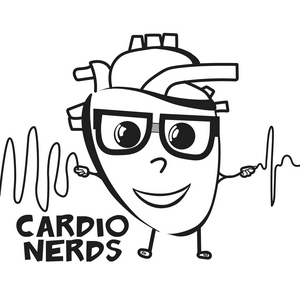415. Case Report: Unraveling MINOCA: Role of Cardiac MRI and Functional Testing in Diagnosing Coronary Vasospasm – The Christ Hospital
CardioNerds (Drs. Daniel Ambinder and Eunice Dugan) join Dr. Namrita Ashokprabhu, Dr. Yulith Roca Alvarez, and Dr. Mehmet Yildiz from The Christ Hospital. Expert commentary by Dr. Odayme Quesada. Audio editing by CardioNerds intern, Christiana Dangas. This episode highlights the pivotal role of cardiac MRI and functional testing in uncovering coronary vasospasm as an underlying cause of MINOCA.
Cardiac MRI is crucial in evaluating myocardial infarction with nonobstructive coronary arteries (MINOCA) and diagnosing myocarditis, but findings must be interpreted within clinical context. A 58-year-old man with hypertension, hyperlipidemia, diabetes, a family history of cardiovascular disease, and smoking history presented with sudden chest pain, non-ST-elevation on EKG, and elevated troponin I (0.64 µg/L). Cardiac angiography revealed nonobstructive coronary disease, including a 40% stenosis in the LAD, consistent with MINOCA. Eight weeks later, another event (troponin I 1.18 µg/L) led to cardiac MRI findings suggesting myocarditis. Further history revealed episodic chest pain and coronary vasospasm, confirmed by coronary functional angiography showing severe vasoconstriction, resolved with nitroglycerin. Management included calcium channel blockers and long-acting nitrates, reducing symptoms. Coronary vasospasm is a frequent MINOCA cause and can mimic myocarditis on CMRI. Invasive coronary functional testing, including acetylcholine provocation testing, is indicated in suspicious cases.
US Cardiology Review is now the official journal of CardioNerds! Submit your manuscript here.
CardioNerds Case Reports PageCardioNerds Episode PageCardioNerds AcademyCardionerds Healy Honor Roll
CardioNerds Journal ClubSubscribe to The Heartbeat Newsletter!Check out CardioNerds SWAG!Become a CardioNerds Patron!
Notes - Coronary Vasospasm
What are the potential underlying causes of MINOCA (Myocardial Infarction with Non-Obstructive Coronary Arteries)?
Plaque Rupture: Plaque disruption, which includes plaque rupture, erosion, and calcified nodules, occurs as lipids accumulate in coronary arteries, leading to inflammation, necrosis, fibrosis, and calcification. Plaque rupture exposes the plaque to the lumen, causing thrombosis and thromboembolism, while plaque erosion results from thrombus formation without rupture and is more common in women and smokers. Intravascular imaging, such as IVUS and OCT, can detect plaque rupture and erosion, with studies showing plaque disruption as a frequent cause of MINOCA, particularly in women, though the true prevalence may be underestimated due to limited imaging coverage.
Coronary Vasospasm: Coronary vasospasm is characterized by nitrate-responsive chest pain, transient ischemic EKG changes, and >90% vasoconstriction during provocative testing with acetylcholine or ergonovine, due to hyper-reactivity in vascular smooth muscle. It is a common cause of MINOCA, with approximately half of MINOCA patients testing positive in provocative tests, and Asians are at a significantly higher risk than Whites. Smoking is a known risk factor for vasospasm. In contrast, traditional risk factors like sex, hypertension, and diabetes do not increase the risk, and vasospasm is associated with a 2.5–13% long-term risk of major adverse cardiovascular events (MACE).
Spontaneous Coronary Artery Dissection: Spontaneous coronary artery dissection (SCAD) involves the formation of a false lumen in epicardial coronary arteries without atherosclerosis, caused by either an inside-out tear or outside-in intramural hemorrhage. SCAD is classified into four types based on angiographic features, with coronary angiography being the primary diagnostic tool. However, in uncertain cases, advanced imaging like IVUS or OCT may be used cautiously. While the true prevalence is unclear due to missed diagnoses, SCAD is more common in women and is considered a cause of MINOCA when i...

